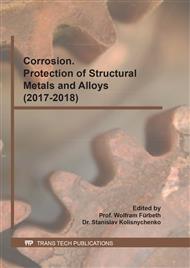[1]
Al-amiery, A. A., Kadhum, A. H., Kadihum, A., Mohamad, A., Hon, C. K. and Junaedi, S. (2014): Inhibition of Mild Steel Corrosion in Sulfuric Acid Solution by New Schiff Base materials, 7(2), 787–804.
DOI: 10.3390/ma7020787
Google Scholar
[2]
Rajalakshmi, R., Prithiba, A., and Lelavathi, S., (2012), An overview of emerging scenario in the frontiers if eco-friendly corrosion inhibitors of plant origin for mild steel, Journal of Chemica Acta (JCA), Vol. 1, 6-13.
Google Scholar
[3]
Raja, P. B., Qureshi, A. K., Rahim, A. A., Osman, H., Awang, K., (2013), Neolamarckia cadamba alkaloids, as ecofriendly corrosion inhibitors for mild steel in 1M HCl media, corrosion science, 69: 292 – 301.
DOI: 10.1016/j.corsci.2012.11.042
Google Scholar
[4]
Oguzie, E. E., Enenebeaku, C. K., Akalezi, C. O., Okoro, S. C., Ayuk, A. A., and Ejike, E. N., (2010).
Google Scholar
[5]
Satapathy, A. K., Gunasekaran, G., Sahoo, S. C., Amit, K., and Rodrigues, P. V., (2009), Corrosion inhibition by Justica gendarussa plant extract in hydrolic acid solution, Corrosion Science, 51, 2848 – 2856.
DOI: 10.1016/j.corsci.2009.08.016
Google Scholar
[6]
Edouk, U., Umoren, S. A., and Udoh, A. P., (2012), Synergistic inhibition effects between leaves and stem extracts of sida acuta and iodide ion for mild steel corrosion in 1 M H2SO4 solutions, Arabian Journal of Chemistry, 5 (3), 325 – 337.
DOI: 10.1016/j.arabjc.2010.09.006
Google Scholar
[7]
Hamdy, A., and El – Glendy, N. S., (2013), Thermodynamic, adsorption and electrochemical studies for corrosion inhibition of carbon steel by henna extract in acid medium, Egyptian Journal of Petroleum, 22, (1), 17 – 25.
DOI: 10.1016/j.ejpe.2012.06.002
Google Scholar
[8]
Patel, N. S., Jauhari, S., and Mehta, G. N., (2009), The Arabian Journal of Science and Engineering, 34: Number 2C.
Google Scholar
[9]
Okafor, P. C., and Ebenso, E. E., (2007), Eco – friendly corrosion inhibitors: inhibitive action of ethanol extracts of black pepper on the corrosion of mild steel in H2SO4, Pigment and resin technology, 36 (3): 134 – 140.
DOI: 10.1108/03699420710820414
Google Scholar
[10]
Raja, P. B., and Sethuraman, M. G., (2008), Natural products as corrosion inhibitor for metals in corrosive media – a review, Material Letter, 62, 113 – 116.
DOI: 10.1016/j.matlet.2007.04.079
Google Scholar
[11]
Nanna, L. A., Uchendu, K. O., Nwosu, F. O., Ihekoronye, U., and Eti, E. P., (2014), Gmelina Arborea Bark Extracts as a Corrosion Inhibitor for mild steel in an acidic environment, International Journal of Materials and Chemistry, 4(2):34 – 39.
Google Scholar
[12]
Sathya, T. A., and Manivannan, T., (2013), Biodiesel Production from neem leaves extract using two step trans-esterification, International Journal of Engineering Research and Applications, Vol. 3, Issue 3, 488- 492.
Google Scholar
[13]
Nwigbo, V. N. Okafor and A. O. Okewale (2012).
Google Scholar
[14]
Herborne, J. B., (1973), Phytochemical Methods, 3rd ed., London, Chapman and Hall Ltd., 135 – 203.
Google Scholar
[15]
Okwu, D. E., (2001), Evaluation of the Chemical Composition of indigenous species and flavouring agents, Global Journal of Pure and Applied Science, 7(3), 455 – 459.
Google Scholar
[16]
Rahilla, T. N., Rukh, S., and Ziaidi, A. A., (1994), Phytochemical Screening of Medicinal Plants belonging to Euphoribiaceae Pak, Veterinary Journal, 14: 160 – 2.
Google Scholar
[17]
Sofowara, A., (1993), Medicinal Plants and Traditional Medicine in Africa, Ibadan, Nigeria, Spectrum Book Ltd., 289.
Google Scholar
[18]
Odeja, O., Obi, G., Ene Ogwuche, C., Elemike, E. E., and Oderinlo, Y., (2015), Phytochemical Screening, Antioxidant and Antimicrobial activities of Senna occidentalis (L.) Leaves Extract, Journal of Clinical Phytoscience, 2 - 6.
DOI: 10.1186/s40816-015-0007-y
Google Scholar
[19]
Prithiba, A., Leelavathi, S. and Rajalakshmi, R., (2014), Application of Natural Products as corrosion inhibitors in different steel and media, Chemical Science Review and Letters, 3, 177 – 187.
Google Scholar
[20]
Owate, I. O., Nwadiuko, O. C., Dike, I. I., Isu, J. O., and Nnanna, L. A., (2014), Inhibition of Mild Steel Corrosion by Aspilia africana in Acidic Solution, American Journal of Materials Science, 4(3) 144–149.
Google Scholar
[21]
Umoren, S. A., Ogbobe, O., Ebenso, E. E., and Ekpe, U. J., (2006), Effect of halide ions on the corrosion inhibitor of mild steel in acidic medium using polyvinyl alcohol, pigment and Resin Technology, Vol. 35, Issue 5, pp.284-292.
DOI: 10.1108/03699420610692896
Google Scholar
[22]
Umoren, S. A., and Ekanem, U. F., (2010), Inhibition of mild steel corrosion in H2SO4 using exudate gum from pachylobus, Edulis and synergistic potassium halides – additives, Chemical Engineering Communications, 197 (10), 1339 – 1356.
DOI: 10.1080/00986441003626086
Google Scholar
[23]
Barmatov, E., Geddes, J., Hughes, T., and Nagi, M., (2012), Research on Corrosion Inhibitors for acid stimulation, in: NACE, C2012 – 0001573.
Google Scholar
[24]
Bentiss, F., Lagrenée, M., Elmehdi, B., Mernari, B., Traisnel, M., and Vezin, H., (2002).
Google Scholar
[25]
Bahrami, S. M., and Ali Hosseini, S.M.,(2012).
Google Scholar
[26]
Okewale, A. O., Omoruwou, F., and Ojaigho, R., (2016), Alternative energy production for Evironmental sustainability, British journal of Renewable energy, 01(02), 18-22.
Google Scholar
[27]
Malarvizhi, M., Sivakumar, D., Thirumalairaj, B., and Jaganathan, M., (2016), Corrosion inhibition of mild steel in 1molL-1 HCl using gum exudates of Azadirachta indica, Advances in Physical Chemistry, 1 – 12.
DOI: 10.1155/2016/5987528
Google Scholar
[28]
Rajeev, P., Surendranathan, A.O. and Murthy, C.S.N., (2012), Corrosion mitigation of the oil well steels using organic inhibitors – A review: Journal of Material Environment Science, 3(5), 856–869.
Google Scholar
[29]
Umoren, S. A., Eduok, U. M., and Oguzie, E. E., (2008), Corrosion Inhibition of mild steel in1M H2SO4 by polyvinyl pyrolidone and synergistic iodide additive, Portugaliae Electrochemica Acta, Vol. 26, Issue 6, 533-546.
DOI: 10.4152/pea.200806533
Google Scholar
[30]
Ayeni. F. A., Alawode, S., Joseph, D., Sukop, P., Olawuyi, V., Alonge, T. E., Alabi, O. O., Oluwabunmi, O., Alo., F. I., (2014).
Google Scholar
[31]
Bouklah, M., Hammouti, B., Benhadda, T. and Benkadour, M. (2005), Thiophene Derivatives as Effective Inhibitors for the Corrosion of Steel in 0.5 M H2SO4, Journal of Applied Electrochemistry, 35, 1095-1101.
DOI: 10.1007/s10800-005-9004-z
Google Scholar
[32]
Rajendran, S., Joany, M. R., Apparao, B. V., and Palaniswamy, N., (2000), Synergistic effect of calcium gluconate and Zn2+ on the inhibition of corrosion of mild steel in neutral aqueous environment, Trans., SAEST., 35(3, 4):113.
DOI: 10.1016/s0013-4686(98)00079-6
Google Scholar
[33]
Cheng, S., Liu, C. T., Chang, X., and Yin, Y., (2007), Carboxymenthylchitosan as an ecofriendly inhibitor for mild steel in 1M HCl, Material Letter, 61:14 – 15, 3276 – 3280.
DOI: 10.1016/j.matlet.2006.11.102
Google Scholar
[34]
Fuchs Godec, R., and Zerjav, G., (2009), Inhibition properties of Triton – X – 100 on Ferritic Stainless steel in Sulphuric Acid at Increasing Temperature, Acta chimica Slovenica, 56(1): 78 – 85.
Google Scholar
[35]
Yaro, A. S., and Khadom, A. A., (2008), Evaluation of the performance of some chemical inhibitors on corrosion inhibition of copper in acid media, Journal of Engineering, 2(14), 2350 – 2362.
Google Scholar



